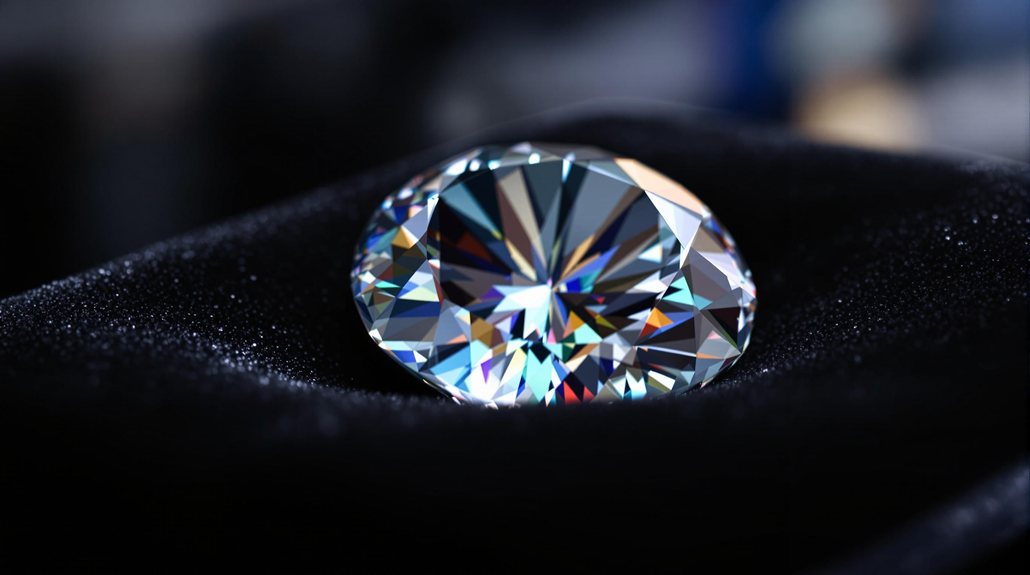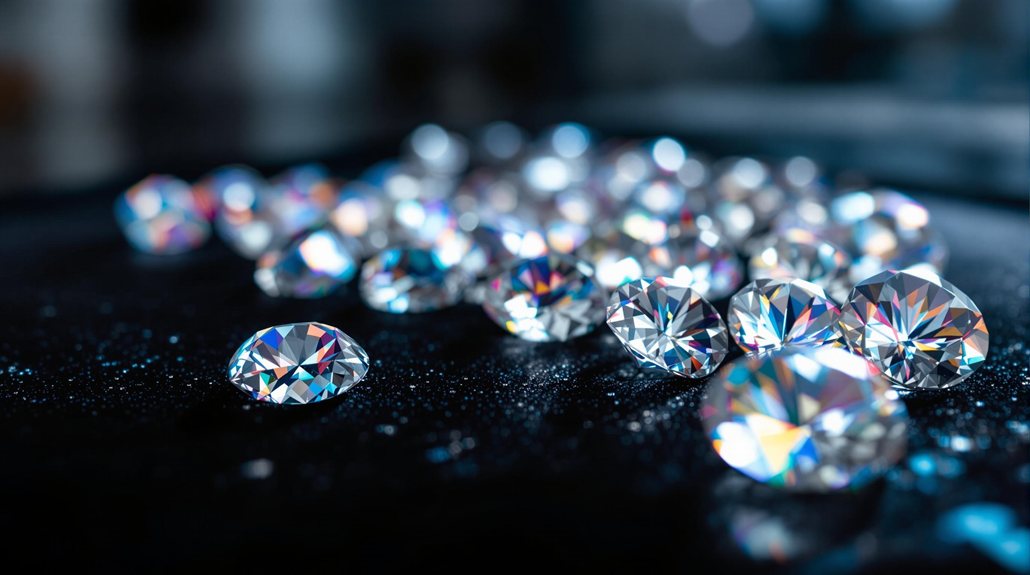Article Contents
- 1 Main Highlights
- 2 Ethical Advantages
- 3 Cost and Accessibility
- 4 Innovative Production Methods
- 5 Rising Market Demand
- 6 Environmental Benefits
- 7 Frequently Asked Questions
- 7.1 How Long Do Lab-Grown Diamonds Take to Form?
- 7.2 Are Lab-Grown Diamonds Distinguishable From Mined Diamonds by Jewelers?
- 7.3 What Maintenance Is Required for Lab-Grown Diamonds?
- 7.4 Can Lab-Grown Diamonds Be Insured Like Mined Diamonds?
- 7.5 Are Lab-Grown Diamonds Affected by Market Price Fluctuations?
- 8 Conclusion
Lab-grown diamonds are increasingly favored as an ethical and affordable alternative to mined diamonds. They boast a considerably lower environmental impact, consuming up to 78% less water and 60% fewer carbon emissions. Produced in controlled laboratories, these diamonds are free from the ethical concerns of forced labor and conflict funding. Their cost advantage, being 40-60% cheaper, makes them accessible to a broader audience, though they have a lower resale value. Moreover, advanced methods like HPHT and CVD allow precise customization and high-quality production. As consumer awareness grows, lab-grown diamonds are reshaping the jewelry industry landscape, promising deeper insights ahead.
Main Highlights
- Lab-grown diamonds are 40-60% cheaper than natural diamonds, making them an affordable option for consumers.
- Their production involves no forced labor or conflict, ensuring ethical sourcing and consumer confidence.
- Lab-grown diamonds have significantly lower environmental impact, with reduced water and energy consumption compared to mined diamonds.
- Customization in size, shape, and color is possible due to innovative production methods like HPHT and CVD.
- Rising consumer awareness and demand for eco-friendly options are driving the growth of the lab-grown diamond market.
Ethical Advantages

Lab-grown diamonds offer numerous ethical advantages that address significant concerns associated with traditional diamond mining. One of the foremost benefits is the elimination of forced and child labor. Unlike conventional mining operations, which have faced criticism for such exploitative practices, lab-grown diamonds are produced in controlled environments, guaranteeing that no human rights abuses occur. This ethical sourcing is a critical factor for consumers who prioritize social justice and wish to support practices that respect basic human rights.
Additionally, lab-grown diamonds are assured to be conflict-free, meaning they do not contribute to funding armed conflicts or exploitation of local communities. This transparency in production fosters greater accountability, providing consumers with confidence about the ethical origin of their purchase. By choosing lab-grown diamonds, individuals can actively promote social justice and contribute to an industry that values human dignity and community welfare.
Furthermore, the production of lab-created diamonds does not result in community displacement or environmental degradation. This guarantees that local communities retain their social integrity and natural habitats are preserved. The innovative technology used in the creation of lab-grown diamonds ensures a minimal environmental footprint, further supporting environmentally-conscious consumer choices. Lab-grown diamonds consume less water, energy, and emit significantly less CO2, making them a more sustainable option compared to natural diamonds.
The traceability of each diamond back to its origin further emphasizes ethical sourcing, making lab-grown diamonds a compelling choice for ethically-conscious consumers.
Cost and Accessibility
How does the cost of lab-grown diamonds improve their accessibility compared to natural diamonds? Lab-grown diamonds present a significant price advantage, being 40-60% cheaper than their natural counterparts. This affordability opens the market to a broader consumer base, aligning with shifting consumer preferences towards ethical and cost-effective alternatives. Historically, lab-grown diamonds were priced higher, yet price trends have shifted, resulting in dramatic decreases. These diamonds now range from under $1,000 to nearly $10,000 per carat, contingent on the 4Cs—cut, color, clarity, and carat—boosting their appeal to diverse buyers. The controlled production environment of lab-grown diamonds allows for precise manipulation of their characteristics, ensuring they meet consumer preferences. Unlike natural diamonds, lab diamonds lack resale value, making them less attractive as long-term investments but appealing for immediate affordability and ethical sourcing.
| Price Range | Affordability | Ethical Considerations |
|---|---|---|
| Under $1,000 | High | Significant |
| $1,000-$5,000 | Moderate | Considerable |
| $5,000-$10,000 | Low | Notable |
The substantial savings on larger diamonds make them particularly attractive, demonstrating the cost-effectiveness of lab-grown gems. However, while they offer immediate financial relief, they carry lower resale value, typically fetching 30-40% less than the purchase price. Despite this, the absence of mining costs and environmental degradation increases their market appeal, marking them as a viable choice for those seeking freedom from traditional diamond constraints. Consequently, lab-grown diamonds meet the growing demand, driven by an informed consumer base valuing both affordability and ethical sourcing.
Innovative Production Methods
While the affordability and ethical advantages of lab-grown diamonds have broadened their appeal, the groundbreaking production methods behind these gems are likewise transformative.
The High Pressure High Temperature (HPHT) method and the Chemical Vapor Deposition (CVD) process stand as two primary production techniques. HPHT involves a growth chamber where a small diamond seed, enveloped in pure carbon, endures intense pressure and temperature, causing the carbon to melt and crystallize around the seed. This method, utilizing presses like the split-sphere, cubic, and belt, mimics natural diamond formation in a controlled setting. This strictly managed setting ensures the consistent quality and characteristics of the diamonds produced. Furthermore, these methods contribute to a more sustainable alternative to traditional mining, which reduces environmental impact significantly.
Conversely, the CVD process employs a sealed container filled with carbon-rich gases such as methane. A diamond seed inside is heated, and the gas is ionized using microwaves or lasers, forming plasma. As carbon atoms deposit layer by layer, technicians intermittently remove graphite crystallization.
Both techniques not only replicate but improve nature's artistry, allowing for unprecedented customization options. Lab-grown diamonds can be tailored in size, shape, and color, offering creative freedom without ecological repercussions.
These innovations underscore a commitment to sustainability and artistry, redefining the landscape of diamond production with precision and ethical integrity.
Rising Market Demand
Amid a shifting landscape in consumer preferences, the demand for lab-grown diamonds is experiencing a robust surge. The global market, valued at USD 18.91 billion in 2023, is projected to expand to USD 34.06 billion by 2030, demonstrating a compound annual growth rate (CAGR) of 8.8%.
This growth reflects a notable shift in consumer preferences, with demand expected to surpass 20% by the end of 2024. The increase in demand from 3.5% in 2018 to 18.5% in 2023 highlights this trend considerably. Technological advancements have played a significant role in this development, enhancing production efficiency and improving quality assessment, which in turn has fueled market expansion. Lab-grown diamonds, such as those produced through chemical vapor deposition (CVD), offer greater control over properties and lower production costs, contributing to their growing popularity.
Affordability plays a key role in this market growth, as lab-grown diamonds are typically 30-40% less expensive than their natural counterparts. This cost-effectiveness, combined with growing ethical awareness, improves their appeal, especially as living standards and disposable incomes rise in developing nations.
The fashion industry, in particular, is experiencing the highest growth rate, driven by consumers' preference for eco-friendly options.
China and India lead in manufacturing, with China accounting for 40-50% of global production. Meanwhile, North America remains the largest consumer.
Companies like Pandora have accepted this trend, shifting to lab-grown diamonds, thereby asserting their market appeal and contributing to the industry's dynamic growth.
Environmental Benefits
Emphasizing sustainability, lab-grown diamonds present considerable environmental benefits over their mined counterparts. The energy efficiency of producing lab-grown diamonds is remarkable, consuming approximately 250 kWh per carat, notably less than the 538.5 kWh for mined diamonds. This process, conducted in a controlled laboratory environment, allows for precision and accuracy, reducing total energy consumption and greenhouse gas emissions. Furthermore, their production can utilize renewable energy sources, such as wind or solar power, enhancing their appeal as a sustainable choice. With the use of recycled and reused by-products, lab-grown diamonds further diminish their environmental footprint, highlighting the sustainability of the lab processes. Beyond energy use, lab-grown diamonds minimize environmental impact through sustainable practices. Water consumption is drastically lower, using about 18 gallons per carat compared to 126 gallons for mined diamonds. Moreover, the lab-grown process avoids land disruption and soil erosion, issues prevalent in traditional mining, by eliminating the need to disturb land or move vast amounts of earth. This protection extends to preserving biodiversity and natural habitats. In terms of carbon emissions, lab-grown diamonds offer a reduction of up to 60%, with some brands even achieving a negative carbon footprint by using captured CO2 as raw material. These practices guarantee a transparent and predictable carbon footprint, appealing to environmentally conscious consumers seeking ethical alternatives. The ethical sourcing practices of lab-grown diamonds ensure that they are free from the human rights abuses often associated with traditional diamond mining.
Frequently Asked Questions
How Long Do Lab-Grown Diamonds Take to Form?
The formation process of lab-grown diamonds varies; typically, growth time ranges from 1 to 2 weeks. Utilizing HPHT or CVD methods, the timeframe depends on desired size and quality, offering a controlled, efficient alternative to natural diamond formation.
Are Lab-Grown Diamonds Distinguishable From Mined Diamonds by Jewelers?
Incredibly, without specialized identification methods, even jewelers are often unable to distinguish lab-grown diamonds from mined ones. This indistinguishability challenges consumer perceptions, offering freedom from traditional constraints, while ensuring ethical considerations are met in diamond purchasing.
What Maintenance Is Required for Lab-Grown Diamonds?
Lab-grown diamonds require regular cleaning techniques such as mild soap solutions and soft-bristled brushes. Although their durability is comparable to mined diamonds, proper care, including avoiding harsh chemicals and professional check-ups, guarantees their longevity and brilliance.
Can Lab-Grown Diamonds Be Insured Like Mined Diamonds?
Insuring lab-grown diamonds is akin to insuring traditional diamonds, though perhaps with a touch less drama. Insurance policies require professional appraisals, acknowledging valuation differences, thereby safeguarding these gems with the same freedom and security.
Are Lab-Grown Diamonds Affected by Market Price Fluctuations?
Lab-grown diamonds are indeed influenced by market price fluctuations, driven by factors such as market demand and evolving consumer perceptions. As consumer interest increases, prices may stabilize, though temporary fluctuations remain influenced by competition and production advancements.
Conclusion
Lab-grown diamonds are transforming the jewelry industry by offering an ethical and affordable alternative to mined diamonds. These diamonds have seen a significant market increase, with a 15% rise in consumer demand annually. The groundbreaking production methods mitigate environmental impacts, reducing carbon emissions by 60% compared to traditional mining. As the demand for sustainable and ethical products continues to grow, lab-grown diamonds are poised to become a staple in the jewelry market, reflecting a shift toward more responsible consumer choices.

